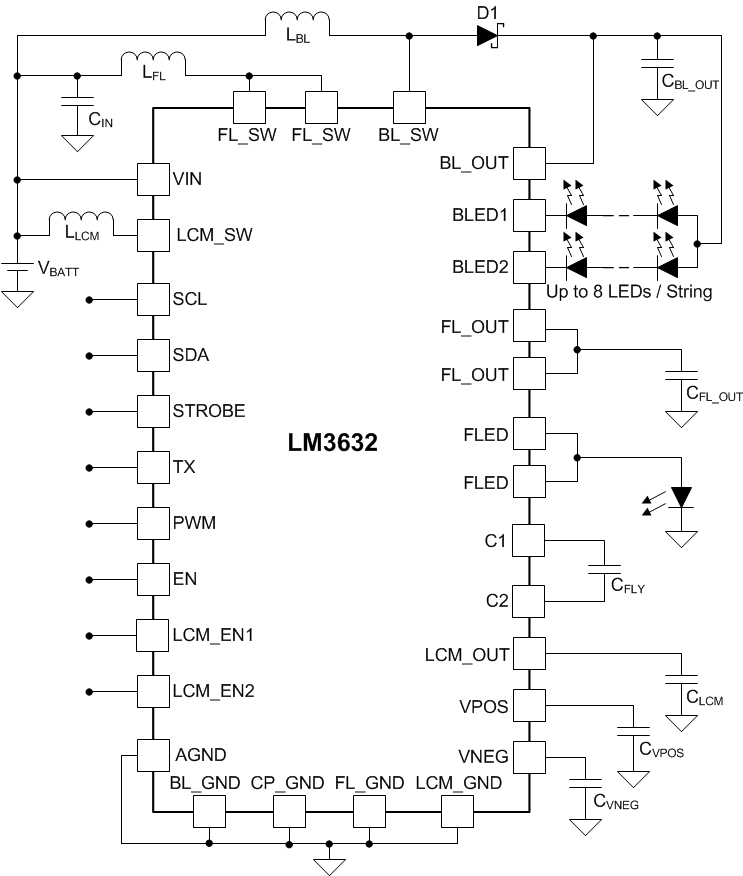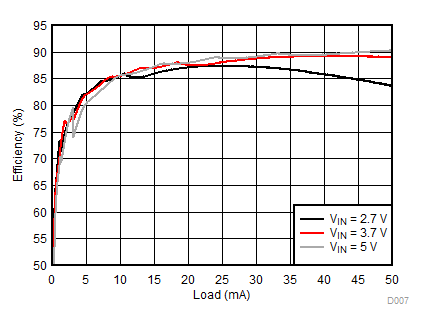ZHCSDN2 April 2015 LM3632A
PRODUCTION DATA.
- 1 特性
- 2 应用
- 3 说明
- 4 修订历史记录
- 5 Pin Configuration and Functions
- 6 Specifications
-
7 Detailed Description
- 7.1 Overview
- 7.2 Functional Block Diagram
- 7.3
Features Description
- 7.3.1 Backlight
- 7.3.2 LCM Bias
- 7.3.3 Flash
- 7.3.4 Software RESET
- 7.3.5 EN Input
- 7.3.6 Thermal Shutdown (TSD)
- 7.4 Device Functional Modes
- 7.5 Programming
- 7.6
Register Maps
- 7.6.1 Revision (Address = 0x01) [reset = 0x05]
- 7.6.2 Backlight Configuration1 (Address = 0x02) [reset = 0x30]
- 7.6.3 Backlight Configuration2 (Address = 0x03) [reset = 0x0D]
- 7.6.4 Backlight Brightness LSB (Address = 0x04) [reset = 0x07]
- 7.6.5 Backlight Brightness MSB (Address = 0x05) [reset = 0xFF]
- 7.6.6 Flash/Torch Current (Address = 0x06) [reset = 0x3E]
- 7.6.7 Flash Configuration (Address = 0x07) [reset = 0x2F]
- 7.6.8 VIN Monitor (Address = 0x08) [reset = 0x03]
- 7.6.9 I/O Control (Address = 0x09) [reset = 0x00]
- 7.6.10 Enable (Address = 0x0A) [reset = 0x00]
- 7.6.11 Flags1 (Address = 0x0B) [reset = 0x00]
- 7.6.12 Display Bias Configuration (Address = 0x0C) [reset = 0x18]
- 7.6.13 LCM Boost Bias (Address = 0x0D) [reset = 0x1E]
- 7.6.14 VPOS Bias (Address = 0x0E) [reset = 0x1E]
- 7.6.15 VNEG Bias (Address = 0x0F) [reset = 0x1C]
- 7.6.16 Flags2 (Address = 0x10) [reset = 0x00]
- 8 Application and Implementation
- 9 Power Supply Recommendations
- 10Layout
- 11器件和文档支持
- 12机械、封装和可订购信息
1 特性
- 可驱动多达两个灯串(通常为 8 个串联的 LED)
- 集成背光升压转换器,最高输出电压达 29V
- 两个低侧恒流 LED 驱动器,最高输出电流达 25mA
- 背光效率高达 90%
- 11 位指数或线性调光
- 具有外部脉宽调制 (PWM) 输入,可实现内容自适应背光控制 (CABC) 背光操作
- LCD 偏置电源效率 > 85%
- 可编程的正 LCD 偏置电源(4V 至 6V),最大输出电流达 50mA
- 可编程的负 LCD 偏置电源(-6V 至 -4V),最大输出电流达 50mA
- 1.5A 闪光灯 LED 升压转换器
- 闪光灯效率 > 85%
- 输入电压范围:2.7V 至 5V
2 应用
- 智能手机 LCD 背光照明和偏置电源
- 小型平板电脑 LCD 背光照明和偏置电源
3 说明
LM3632A 器件集成了用于 LCD 面板背光照明和摄像机闪光灯的白光发光二极管 (WLED) 驱动器以及用于 LCD 面板的偏置电源。 该器件具备 LED 驱动器所需的全套安全功能,并且效率高达 90%,正/负偏置电源轨精度高达 1.5%。 该器件最多能够驱动 16 个背光 LED,是中小型显示屏的理想选择。 该器件可使用由同步升压转换器供电的 1.5A 恒流 LED 驱动器来驱动闪光灯。 高侧闪光灯电流源支持 LED 阴极接地操作。
LM3632A 兼具高集成度和可编程性,无需修改硬件即可适应各类应用。
器件信息(1)
| 器件型号 | 封装 | 封装尺寸(最大值) |
|---|---|---|
| LM3632A | DSBGA (30) | 2.47mm x 2.07mm |
- 要了解所有可用封装,请见数据表末尾的可订购产品附录。
简化电路原理图

背光效率,2P7S
